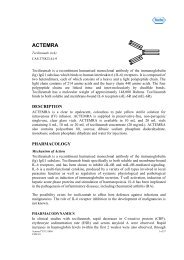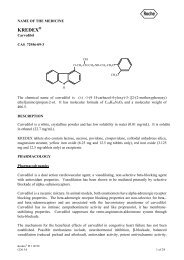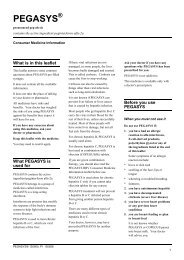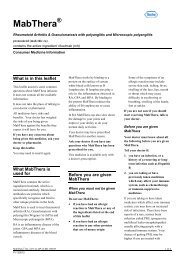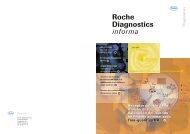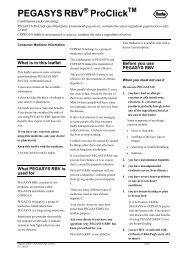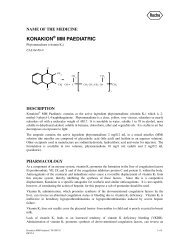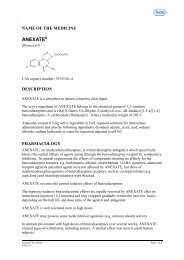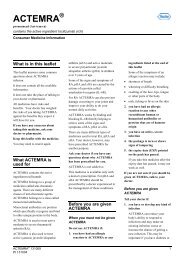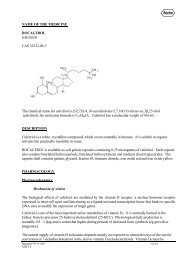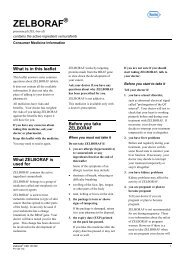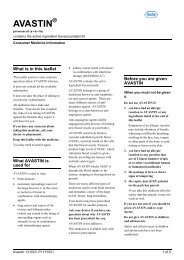Product Information PI - Roche Australia
Product Information PI - Roche Australia
Product Information PI - Roche Australia
Create successful ePaper yourself
Turn your PDF publications into a flip-book with our unique Google optimized e-Paper software.
Adults and Adolescents 4/1245 (0.32%) 5/1245 (0.4%)<br />
Children (1 – 12 years) 19/464 (4.1%) 25/464 (5.4%)<br />
* Full genotyping was not performed in all studies.<br />
In clinical studies conducted in post-exposure (7 days), post-exposure within household<br />
groups (10 days) and seasonal (42 days) prophylaxis of influenza in immunocompetent<br />
persons, there was no evidence for emergence of drug resistance associated with the use of<br />
TAMIFLU. There was no resistance observed during a 12-week seasonal prophylaxis study<br />
in immunocompromised subjects.<br />
Clinical and surveillance data: Natural mutations associated with reduced susceptibility to<br />
oseltamivir in vitro have been detected in influenza A and B viruses isolated from patients<br />
without exposure to oseltamivir. For example, in 2008 the oseltamivir resistance-associated<br />
substitution H275Y was found in > 99 % of circulating 2008 H1N1 influenza isolates in<br />
Europe, while the 2009 H1N1 influenza (“swine flu”) was almost uniformly susceptible to<br />
oseltamivir. Resistant strains have also been isolated from both immunocompetent and<br />
immunocompromised patients treated with oseltamivir. The susceptibility to oseltamivir and<br />
the prevalence of such viruses appears to vary seasonally and geographically. Oseltamivir<br />
resistance has also been reported in patients with pandemic H1N1 influenza in connection<br />
with both therapeutic and prophylactic regimens.<br />
The rate of emergence of resistance may be higher in the youngest age groups, and in<br />
immunocompromised patients. Oseltamivir-resistant viruses isolated from oseltamivir-treated<br />
patients and oseltamivir-resistant laboratory strains of influenza viruses have been found to<br />
contain mutations in N1 and N2 neuraminidases. Resistance mutations tend to be viral subtype<br />
specific.<br />
Prescribers should consider available information on influenza virus drug susceptibility<br />
patterns for each season when deciding whether to use TAMIFLU (for the latest information,<br />
please refer to WHO and/or local government websites).<br />
Cross-Resistance<br />
Cross-resistance between zanamivir-resistant influenza mutants and oseltamivir-resistant<br />
influenza mutants has been observed in vitro. Due to limitations in the assays available to<br />
detect drug-induced shifts in virus susceptibility, an estimate of the incidence of oseltamivirresistance<br />
and possible cross-resistance to zanamivir in clinical isolates cannot be made.<br />
However, two of the three oseltamivir-induced mutations (E119V, H274Y and R292K) in the<br />
viral neuraminidase from clinical isolates occur at the same amino acid residues as two of the<br />
three mutations (E119G/A/D, R152K and R292K) observed in zanamivir-resistant virus.<br />
Pharmacokinetics<br />
Absorption<br />
Oseltamivir is absorbed from the gastrointestinal tract after oral administration of oseltamivir<br />
phosphate and is converted predominantly by hepatic esterases to the active metabolite. In<br />
multiple dose studies the peak concentration of the active metabolite occurs 2 – 3 hours after<br />
Tamiflu <strong>PI</strong> 6 mg/mL oral suspension and capsules 120119 3 of 28<br />
CDS 10.0



